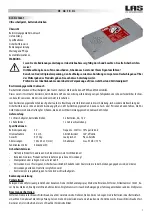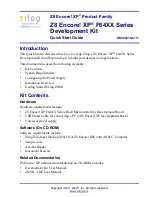
274
XMEGA B [DATASHEET]
8291B–AVR–01/2013
The recommendations for the maximum receiver baud rate error assume that the receiver and transmitter equally divide
the maximum total error.
21.9
Fractional Baud Rate Generation
Fractional baud rate generation is possible for asynchronous operation due to the relatively high number of clock cycles
for each frame. Each bit is sampled sixteen times, but only the three middle samples are of importance. The total number
of samples for one frame is also relatively high. Given a 1-start, 8-data, no-parity, and 1-stop-bit frame format, and
assuming that normal speed mode is used, the total number of samples for a frame is (1+8+1)×16 or 160. As stated
earlier, the UART can tolerate some variation in clock cycles for each sample. The critical factor is the time from the
falling edge of the start bit (i.e., the clock synchronization) until the last bit's (i.e., the first stop bit’s) value is recovered.
Standard baud rate generators have the unwanted property of having large frequency steps between high baud rate
settings. The worst case is found between the BSEL values 0x000 and 0x001. Going from a BSEL value of 0x000, which
has a 10-bit frame of 160 clock cycles, to a BSEL value of 0x001, with 320 clock cycles, gives a 50% change in
frequency. Ideally, the step size should be small even between the fastest baud rates. This is where the advantage of the
fractional baud rate generator emerges.
In principle, the fractional baud rate generator works by doing uneven counting and then distributing the error evenly over
the entire frame. A typical count sequence for an ordinary baud rate generator is:
2, 1, 0, 2, 1, 0, 2, 1, 0, 2, …
which has an even period time. A baud rate clock ticks each time the counter reaches zero, and a sample of the signal
received on RxD is taken for every 16th baud rate clock tick.
For the fractional baud rate generator, the count sequence can have an uneven period:
2, 1, 0, 2, 1-1, 0, 2, 1, 0, 2, 1-1, 0,...
In this example, an extra cycle is added to every second baud clock. This gives a baud rate clock tick jitter, but the
average period has been increased by a fraction of 0.5 clock cycles.
shows an example of how BSEL and BSCALE can be used to achieve baud rates in between
what is possible by just changing BSEL.
The impact of fractional baud rate generation is that the step size between baud rate settings has been reduced. Given a
scale factor of -1, the worst-case step then becomes from 160 to 240 clock cycles per 10-bit frame, compared to the
previous step of from 160 to 320. A higher negative scale factor gives even finer granularity. There is a limit,however, to
how high the scale factor can be. The value 2
|BSCALE|
must be at most half the minimum number of clock cycles of a
frame. For instance, for 10-bit frames, the minimum number of clock cycles is 160. This means that the highest
applicable scale factor is -6 (2
I-6I
= 64 < (160/2) = 80).
For higher BSEL settings, the scale factor can be increased.
shows BSEL and BSCALE settings when using the internal oscillators to generate the most
commonly used baud rates for asynchronous operation and how reducing the BSCALE can be used to reduce the baud
rate error even further.
8
96.00
103.90
+3.90/-4.00
± 1.5
9
96.39
103.53
+3.53/-3.61
± 1.5
10
96.70
103.23
+3.23/-3.30
± 1.0
D
#(Data + Parity Bit)
R
slow
[%]
R
fast
[%]
Max Total Error [%]
Recommended Max
Receiver Error [%]
Содержание XMEGA B
Страница 320: ...320 XMEGA B DATASHEET 8291B AVR 01 2013 Table 25 12 7 segments Character Table...
Страница 321: ...321 XMEGA B DATASHEET 8291B AVR 01 2013 Table 25 13 14 segments Character Table...
Страница 322: ...322 XMEGA B DATASHEET 8291B AVR 01 2013 Table 25 14 16 segments Character Table...
Страница 412: ...412 XMEGA B DATASHEET 8291B AVR 01 2013...
Страница 413: ...413 XMEGA B DATASHEET 8291B AVR 01 2013...
Страница 414: ...414 XMEGA B DATASHEET 8291B AVR 01 2013...
















































